The Return of the King, Graphene has published 6 Nature / Science this year
QQ Academic Group: 1092348845
Detailed
Graphene is also known as "black gold" and "king of new materials" . It is known as the "magic material" that changes the 21st century, not only in the fields of aerospace, solar energy utilization, nanometers, electronics, biomedicine, composite materials, etc. It is widely used and has unique commercial application potential in our clothing and daily necessities. The 2010 Nobel Prize in Physics was awarded to André Gem and Konstantin Novoslov, scientists at the University of Manchester, who made outstanding contributions to graphene research. As a "magic material" in the 21st century, graphene will surely bring about tremendous changes to human life and have a disruptive impact on the world. This article summarizes the breakthrough achievements in the field of graphene in Science and Nature this year, and discusses with you.
1. Nature: Rapid synthesis of gram-grade graphene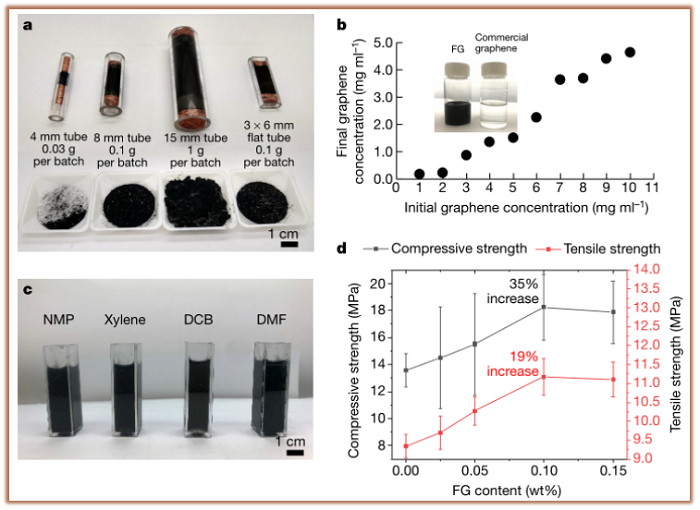
The team of Professor Rouzbeh Shahsavari of Rice University, Professor Boris I. Yakobson and Professor James M. Tour demonstrated the use of Joule heating of cheap carbon sources-such as coal, petroleum coke, biochar, carbon black, waste food, rubber tires and Mixed plastic waste can synthesize a large amount of graphene in less than one second. The product, named after its production process, quickly prepared graphene (FG), shows the turbocharged arrangement between stacked graphene layers. The rapid synthesis process does not require a heating furnace, solvents and reactive gases. The output depends on the carbon content of the raw material. When using a high carbon source, such as carbon black, anthracite or calcined coke, the output can reach 80% -90%, the purity is greater than 99%, and no purification treatment is required. Raman spectroscopy analysis shows that FG has a low intensity or missing D band, which indicates that FG has a very low defect concentration, and confirms FG‘s turbine strain accumulation. The disordered orientation of the FG layer facilitates its rapid flaking after mixing during the formation of the composite material. The electricity cost of synthetic FG is only 7.2 kilojoules per gram, which makes FG suitable for plastics, metals, plywood, concrete and other composite materials. Literature link: https://www.nature.com/articles/s41586-020-1938-0
2. Nature: Proton-assisted ultra-smooth graphene film
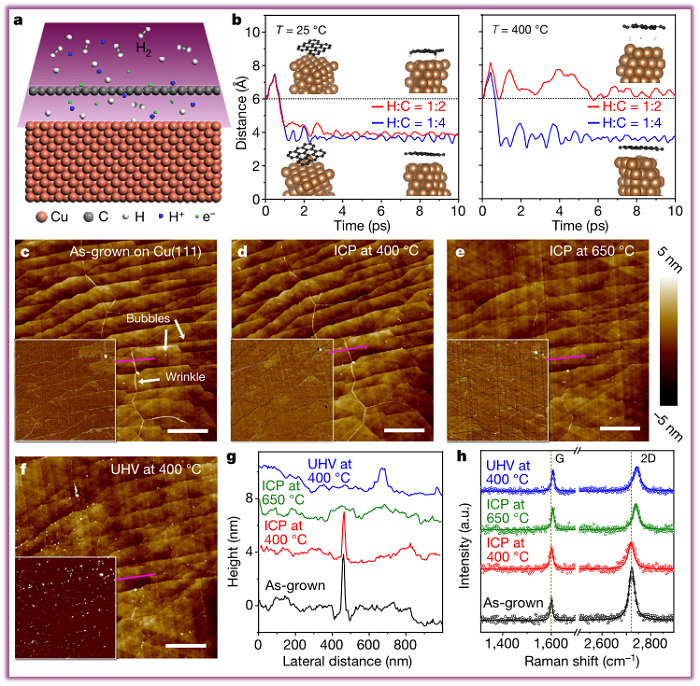
Prof. Gao Libo‘s team at Nanjing University has developed a proton-assisted chemical vapor deposition method to grow ultra-smooth graphene films without wrinkles. The method of proton penetration and recombination to form hydrogen can reduce the wrinkles formed by graphene during traditional chemical vapor deposition. Due to the decoupling of van der Waals force interaction and the increase of the distance from the growth surface, some folds completely disappeared. The electron band structure of the graphene film is a V-shaped Dirac cone, and there is a linear dispersion relationship in the atomic plane or between atomic steps, which confirms the decoupling effect with the substrate. The ultra-smooth nature of the graphene film ensures that its surface is easy to clean after wet transfer. In devices with a line width of 100 microns, a strong quantum Hall effect occurs even at room temperature. The graphene film grown by proton-assisted chemical vapor deposition can maintain its inherent performance to a large extent, and this method should be generalized to other two-dimensional materials. Literature link: https://www.nature.com/articles/s41586-019-1870-3
3. Nature: Heterogeneous integration of single crystal composite oxide film. The
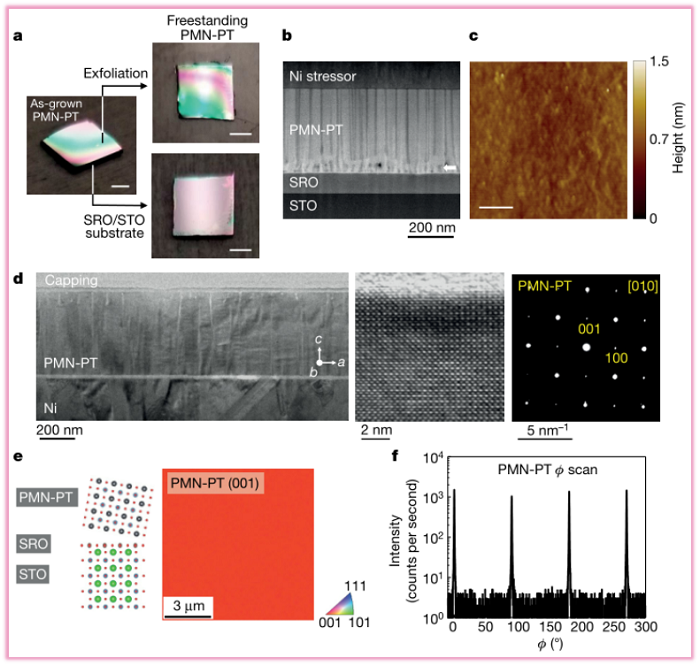
team of Professor Jeehwan Kim of the Massachusetts Institute of Technology and Professor Chang-BeomEom of the University of Wisconsin-Madison demonstrated a general mechanical peeling method to produce independent single crystals. Membranes include various complex oxide complexes with different crystal orientations of perovskite, spinel and garnet crystal structures. In addition, the researchers prepared artificial heterostructures and hybridized their physical properties by directly stacking such free-standing thin films with different crystal structures and orientations, which cannot be achieved by traditional methods. The results of this study establish a platform similar to the superposition and coupling of three-dimensional structures of two-dimensional material heterostructures to enhance device performance. Literature link: https://doi.org/10.1038/s41586-020-1939-z
4. Nature: tunable associated Chen ’s insulator in the Mohr superlattice and ferromagnetic
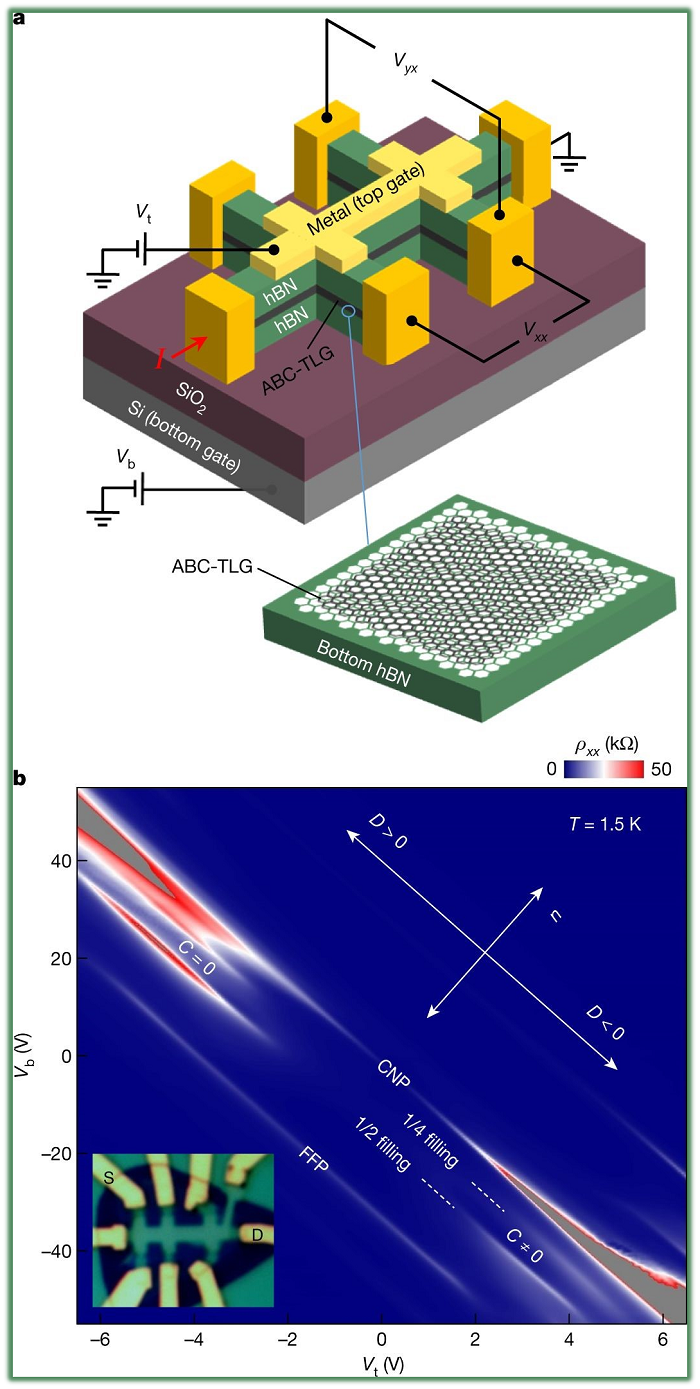
Professor Zhang Yuanbo ’s team at Fudan University, Lawrence Berkeley National Experiment room / University of California, Berkeley Professor Wang Feng team , SLAC national accelerator laboratory David Goldhaber-Gordon team joint report experimental observations related to Chen insulator in the ABC-TLG / hBN Moore superlattices. The results show that the reverse application of a vertical electric field can cause the ABC-TLG / hBN Moiré microstrip to change between zero and a finite Chen number, which is related to the change in magnetic transmission behavior. For topological hole microstrips adjusted to have a finite Chen number, the researchers focused on quarter filling, corresponding to one hole. The Hall resistance is well quantized at h / 2e 2 (where h is the Planck constant and e is the charge on the electron), which means that for a magnetic field exceeding 0.4 Tesla, C = 2. The related Chen‘s insulator is ferromagnetic and exhibits significant hysteresis and a large abnormal Hall signal under zero magnetic field. The researchers discovered Chen‘s insulator with C = 2 under the condition of zero magnetic field, which will provide the possibility of discovering the related topological state later.Literature link: https://www.nature.com/articles/s41586-020-2049-7
5. Nature: The gas permeability limit of graphene The
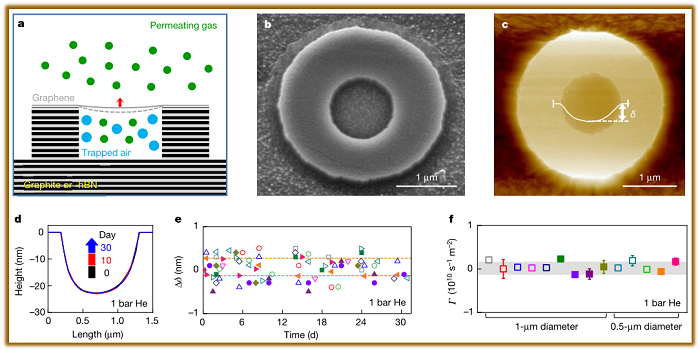
University of Manchester Nobel Laureate Professor AK Geim team uses small graphene to seal For single crystal containers, the study found that defect-free graphene is impermeable to water, and its accuracy is 8-9 orders of magnitude higher than previous studies. The researchers were able to discern the penetration of only a few helium atoms per hour, and this detection limit also applies to all other test gases (neon, nitrogen, oxygen, argon, krypton, and xenon) except hydrogen. Although hydrogen molecules are larger than helium molecules and undergo a higher energy barrier, they still show significant penetration. This unusual result is attributed to the two-stage process, which involves dissociation of hydrogen molecules at the highly catalytically active graphene ripples, followed by the adsorption of hydrogen atoms with relatively low activation energy to transition to graphene sheets. The other side. This research work provides a key reference for the impermeability of two-dimensional materials, and is of great significance from the perspective of basic research and their potential applications. Literature link: https://www.nature.com/articles/s41586-020-2070-x
6, Science: Spiral quantum Hall phase of graphene on SrTiO3 substrate
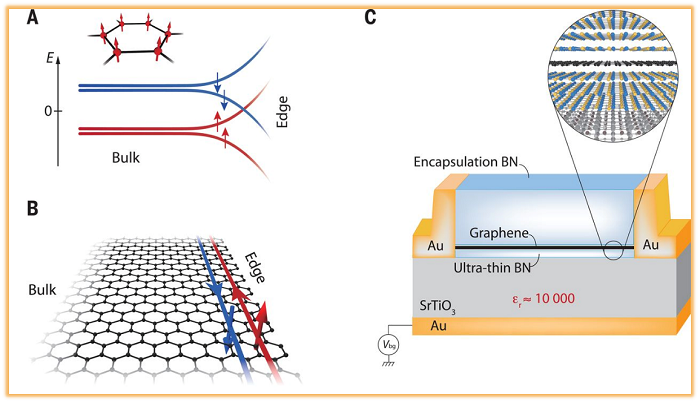
The team of Professor Benjamin Sacépé of Grenoble-Alpes University in France adjusted the ground state of the zero-order Landau energy level of graphene to the appropriate level by increasing the Coulomb interaction and using strontium titanate (SrTiO 3 ) with high dielectric constant as the substrate. Topological phase. With this method, a significant spiral edge transmission occurs in a magnetic field as low as 1 Tesla, and the temperature can withstand up to 110 Kelvin over a long distance of microns. This research is of great significance for exploring the zero-energy mode in superconducting approximate structures based on spiral edge construction. Substrate screening engineering with adjustable hBN spacer layer thickness may affect other related 2D systems. This general-purpose graphene platform can play a role in spintronics and topological quantum computing. Literature link: https://science.sciencemag.org/content/367/6479/781
Source:
- Previous: AG真人正规平台网站521006914微Q
- Next: 1


 About us
About us